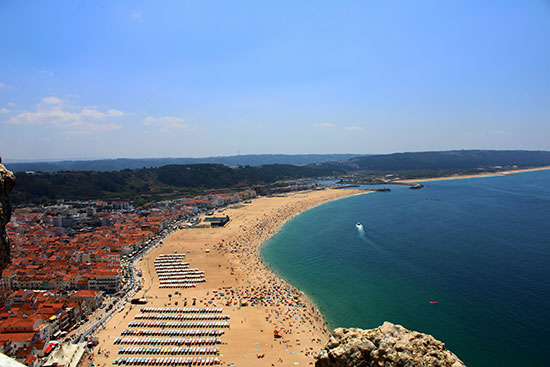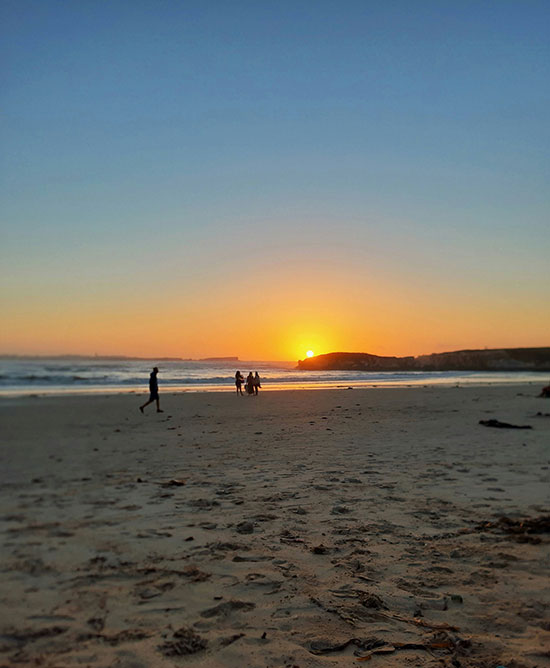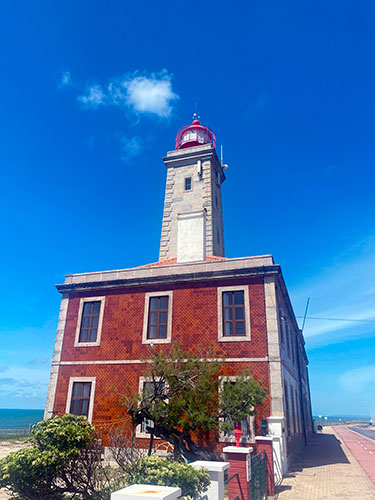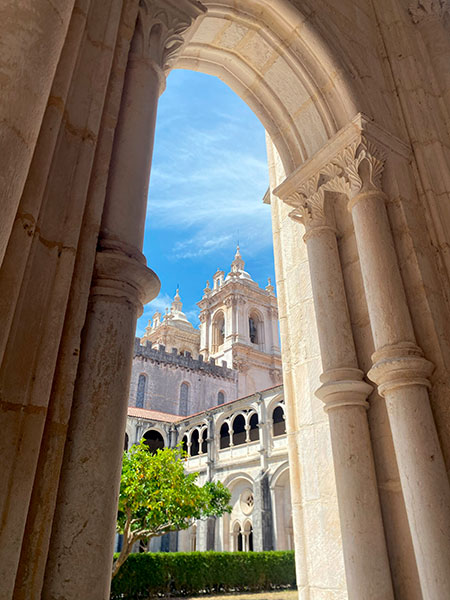Leiria is undoubtedly a privileged destination for those looking for excellent beaches: from its extensive sandy beaches ideal for surfing to quiet river coves perfect for families!
Here we present what we consider to be the best beaches in the district, highlighting those that have been awarded Blue Flag, Zero Pollution, and Gold Quality status.

1. Nazaré Beach
Nazaré Beach is one of the most iconic beaches in the district of Leiria and in Portugal. Famous for the giant waves formed by the Nazaré Canyon, it has become a world-renowned surfing spot especially after Garrett McNamara surfed a wave of about 30 meters in 2011.
In addition to the adrenaline rush, Nazaré offers facilities for families, surveillance, and access for people with reduced mobility, making it one of the most popular beaches in the region.
2. Baleal Beach
Located in Peniche, Praia do Baleal stands out for its excellent surfing conditions, with features such as a peninsula separating two bays—one with calmer waters, ideal for families, and the other with stronger waves, perfect for surfers.
The beach has good access and infrastructure, and some of its areas (such as Baleal-Sul, Norte, and Campismo) have even been awarded the Zero Pollution seal.

3. Consolação Beach
Also in Peniche, Consolação Beach is known for its therapeutic waters, rich in iodine, which provide rheumatic and bone benefits.
Divided by a strong history, it offers two types of sand: one extensive and the other rocky with medicinal properties. The beach is supervised and easily accessible.
4. São Pedro de Moel Beach
Between the pine forest of Leiria and the Atlantic, São Pedro de Moel stands out for its aristocratic landscape—with the Penedo da Saudade Lighthouse framing the scene since 1912.
It is popular with families and surfing and bodyboarding enthusiasts, and offers outdoor sports, restaurants, and camping areas.

5. Pedrógão Beach
Located in the municipality of Leiria, Pedrógão Beach has an extensive sandy beach of about 1,400 meters, with dunes that shelter pioneer flora — although threatened by erosion.
It is a place of great natural beauty, steeped in history, with traces of a bastion destroyed by the 1755 earthquake and easy access to the calm sea.
6. Praia da Vieira
Bordered by the Lis River and the Leiria Pine Forest, Praia da Vieira is extensive and well-equipped to welcome tourists, with a water park, hotels, restaurants, and bars by the sea.
It is ideal for families and those looking for a variety of leisure options.
7. Other coastal beaches worth mentioning
Take the opportunity to explore other beaches that may surprise you while visiting Leiria:
. Praia Velha: quiet and ideal for walks, with boardwalks and impressive dunes;
. Pedra D'Ouro: a wide beach surrounded by black hills and captivating geological features;
. Paredes da Vitória: close to the Monastery of Alcobaça, it is a family beach with curious rock formations (“lion”) and good infrastructure.
8. River beaches
If you prefer the calm waters of the river to the sea, discover some of the best river beaches in the district:
. Poço Corga river beach: located in Pedrógão Grande, it offers clear waters, picnic areas, a playground, shade from oak trees, and a museum that tells the local history;
. Fragas de São Simão river beach: impressive and surrounded by unique rock formations, ideal for hiking and diving in crystal clear waters.
9. Tips to make the most of your visit
To make the most of the best beaches in the district of Leiria:
. Look for beaches with Blue Flag or Zero Pollution certification for safety and quality;
. For surfing or adventure, choose Nazaré, Baleal, or São Pedro de Moel;
. If you prefer tranquility, go for river beaches such as Poço Corga or Fragas de São Simão.
Things to do when the weather isn't cooperating
As locals, we know that the weather in the West isn't great for those seeking the Algarve sun, so it's always good to have a plan B, C, and maybe even D!
Leiria Castle:
At the top of the hill stands the towering castle of Leiria, founded by the first Portuguese king, Afonso Henriques. It is well worth a visit, not only for its architecture and the iconic window of King Dinis, but also for its views over the city.

Ourém Castle:
Ourém Castle was founded in the 12th century by King Afonso Henriques. Towering and Romanesque in style, it is well worth a thorough visit. We highlight the Paços dos Condes de Ourém (Palace of the Counts of Ourém);
Porto de Mós Castle
This is one of the least known castles in Portugal, yet its design makes it one of the most beautiful in the country. It was conquered from the Moors by Fuas Roupinho in 1148.
Alcobaça Monastery
This monastery is the first example of Gothic architecture in Portugal and was home to Cistercian monks for over 800 years. In addition to the genius of its construction inside the church, we recommend seeing the medieval tombs of King Pedro I and Queen Inês de Castro, which probably hide the most tragic love story in the country.

Monastery of Batalha
The Monastery of Batalha, or Santa Maria da Vitória, was founded to celebrate the Portuguese victory over the Spanish army that had invaded Portugal to claim the throne in what would come to be known as the “War of Succession,” which lasted from 1383 to 1385.
Inside, you will find the first national pantheon, where a large part of the famous illustrious family is buried, with the central tomb of King João I and his queen, Filipa de Lencastre, standing out.
We also highlight the famous imperfect chapels built in the Manueline style.
Caldas da Rainha Thermal Hospital
This was founded in 1484/1485 by Queen Leonor and is considered the oldest thermal hospital in the world still in operation.
This queen went down in history as the “Most Perfect” for having founded the Santa Casa da Misericórdia institution, which still exists today in Portugal, Brazil, and Macau.
Inside the Thermal Hospital, we recommend a visit to the old Queen's Pool, which is the only part of the original building that has survived to this day.
For nature lovers
If you're not interested in history but love nature, then Leiria may surprise you. Between natural beauty and trails, the choice is yours, of course.
Gruta da Moeda
Located in São Mamede in the municipality of Batalha, this is one of the most beautiful caves in the region. At 45 meters deep, these caves were only discovered in 1971.
Mira de Aire Caves
These caves are deeper than the previous ones, at around 110 meters deep. They were discovered in 1947 and are now open to visitors. They are located in Mira de Aire, near the village of Porto de Mós.

Viewpoint of the natural amphitheater of Fórnea de Alcaria
If you enjoy walking, take the trail that will lead you to “Fórnea.” This trail is located in the Serras de Aire e Candeeiros Natural Park, surrounded by lush nature.
Fórnea is a natural amphitheater about 1 km in diameter, carved out of the marly limestone, marl, and limestone of the Lower and Middle Jurassic periods, making it a place rich in fossils.



